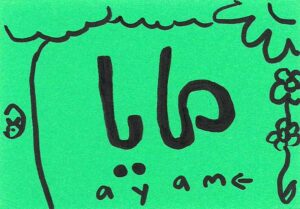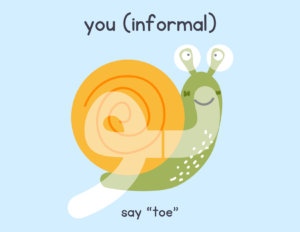If you purchase products or books I recommend from Bookshop.org after clicking on the links in this post, I might receive a commission of 10% of the purchase price. The commissions help fund the cost of hosting this website. I also link to other retailers that do not give me a commission. I only recommend items that I personally love. I always thoroughly research products and books before recommending to make sure they are high quality and relevant to my readers. Read more in my Privacy Policy and Disclosures.
Learn to Write in Farsi (Persian) and Have Fun Doing It

Doing something meaningful grows our confidence, motivation, and positive associations with the subject.
Yes, it is possible to have fun and learn to write in Farsi (Persian) at the same time. The key is empowerment. I’m talking about learning to do something for a real purpose, rather than doing rote memorization or redundant exercises.
Doing something meaningful grows our confidence, motivation, and positive associations with the subject we’re learning. I know I’m a word nerd by profession, but I’m not the only person who thinks learning to write in Farsi through creating our own written content is fun. Kids love being empowered to do things themselves (just ask my toddler, whose current favorite phrase is “ahdooee,” which means “I do it!”). We never outgrow that need for empowerment. I bet you and your family will love it too!
Meaningful Projects to Practice Writing in Farsi (Persian)

The goal is to get familiar with the letter sounds and shapes, not to be perfect.
As you do these exercises, focus on sounding out each word and matching each sound to a Farsi letter. Use the free Farsi alphabet poster as a quick reference for letter sounds. Don’t worry about getting the right letter in cases where multiple letters make the same sound (I’m looking at you ز ذ ض and ظ). After you’ve made your best guess, you can look it up in a dictionary or ask a fluent speaker to check your work if you want to know the correct spelling for future reference. But remember: the goal is to match letters to sounds and practice writing them out. The goal is not to be perfect. No one is grading you.
Refer to A Little Farsi Alphabet Book or your preferred learning resource to see if a letter connects to the other letters around it. Don’t be discouraged if your handwriting looks like a deranged chicken danced across your paper. My Farsi handwriting does too. I swear it’s beautiful in English!
Your own name.
I choose to spell mine مایا (ma-yah), which is how native Farsi speakers usually spell and pronounce it.
Apologies to anyone named “Anne,” because if you happen to choose ع (‘eyn) as the beginning letter, it’ll mean something you probably don’t want to be called (💩). You might want to spell it آن (pronounced ‘ãn,’ with an ‘a‘ like ‘arm’) instead.

Other people’s names.
Non-Persian names are a good place to start (unless their name is Anne 😅) because you can simply sound it out and make up your own Farsi spelling without offending anyone with a technical misspelling. For example, Karen: I choose to spell it کَرِن (Káren, with an ‘a‘ like ‘and’). I’ve seen others spell it کارِن (Kãren, with an ‘a’ like ‘arm’).
You can ask Persian friends and family how to correctly spell their names in Farsi script so you can write it out for practice. I also like learning the meanings of Persian names. Sometimes people don’t know their name’s meaning and we have fun looking up possible meanings together! For example, the name Máhyãr (مَهیار): “Máh” is a contraction of the word “Mãh” for “moon,” and “yar” is a poetic word for “companion” or “friend.” So this name means “the moon’s companion.” Pretty neat, huh?
Words you think are fun to say.
Start your own little reference dictionary with your favorite Farsi words. One of the first words I learned to spell was اُردَک (ordák, meaning duck). I used to tease my family that “ordák” would be a cute name for our first child. (I think I’m very funny, but I guess it’s a good thing I didn’t pursue standup comedy as a career.) More fun words are کِشمِش (keshmesh – raisin) and سِکسِکِه (seksekeh – hiccup).
Add rhyming or visually similar words like “موزِ بُز” (Moz-e-boz, both pronounced with ‘o‘ like ‘rose’ – Banana, the goat), or کَفشِ بَنَفش (káfsh-e-bánáfsh – purple shoes).
Make illustrations for your dictionary entries to remind you of the shapes of words or letter. The word “تو” (informal ‘you,’ pronounced like the English word ‘toe’) looks to me like a little snail, and that helps me remember how to spell it.

Words that sound the same or similar in Farsi and English.
For example, “avocado” is “آووکادو” (pronounced ‘ah-vo-kah-doh’) and “galosh” (like a rain boot) is “گالِش” (pronounced ‘gah-lesh’).
There are a lot of overlapping words in Farsi and English because of the global nature of our society, plus the historical interactions that introduced Arabic, Greek, and Latin root words into both Farsi and English.

But a word of warning! Like the name “Anne,” some words in English mean something entirely different, and sometimes bad, in Farsi. Don’t ask me about the time I tried to spell the English word “coaster” and my mother in law nearly had a heart attack. Whoops!
Text messages to friends and family who read Farsi.
Start simple, like “سَلام” (sálãm – hello) or “شَب بخِیر” (sháb bekheyr – good night).
Ask them to text you back simple phrases so you can sound them out.
If you’re thick skinned, ask them to correct any mistakes you make.
If corrections would feel too discouraging to you, ask them directly not to correct your mistakes. It’s okay to set that boundary.
Unless you’ve signed up for a class with a grade, there’s no rule saying you have to take corrections. Are corrections helpful? Of course–but only when we’re ready to hear them. When we’re not ready, even well-intended corrections might make us feel like shutting down–especially if we already struggle with perfectionism.
If your texting partner isn’t able to keep their corrections to themselves after you’ve asked, then maybe that person isn’t the right texting partner to practice with.
Find someone who can let go of that impulse. Wait until your confidence is built up a bit and you feel ready to accept feedback. Then try to expand your circle of Farsi texting partners again.
Stories, poems, and songs.
Translate a simple children’s book (like One Fish, Two Fish, or Biscuit). Or make up your own. Maybe a comic about two animals with funny names like “Keshmesh” greeting each other. This is especially fun to do with kids. Teens and tweens might surprise you with how funny they are in comic strip form! If you have a younger kid, you can ask them to make up a character and story like “a Boz named Moz went to school” and ask them to illustrate it with you. It doesn’t need to be complex. You don’t even have to write the whole thing in Farsi. Any level of practice is good!
Take an easy tune you know like “row your boat” and change the words to a Farsi rhyme. You could translate the English directly, or make up something entirely new with the same rhythm: موز موز موزِ بُز (moz moz moz-e-boz – banana banana banana the goat).
Set yourself a challenge you’d enjoy. What do you think is fun to write? A couplet, a rap song, or a nonsense rhyme? A haiku, perhaps?

What are your favorite Farsi learning activities?
I hope these suggestions help bring some joy into your playtime, with the added benefit of learning Farsi together as a family! Do you have any activity suggestions you’d like to share with my readers? Favorite learning resources or strategies to recommend? Send me an email (maia@littlefarsibooks.com) or contact me with this form!
